Why Antique Drop Leaf Oval Tables Are Perfect for Modern Living
An antique drop leaf oval table combines timeless elegance with smart space-saving design. These versatile pieces feature hinged side panels (leaves) that fold down for compact storage or extend to create a full dining surface. Dating back to the 18th century, they evolved from gateleg tables and became essential furniture in homes where space was precious.
Key Features of Antique Drop Leaf Oval Tables:
- Space-saving design - Leaves fold down to create narrow console
- Expandable surface - Opens to accommodate 4-8 people depending on size
- Historical styles - Georgian, Queen Anne, Victorian, and Sheraton designs
- Quality materials - Mahogany, oak, walnut, and cherry wood construction
- Support mechanisms - Gateleg, Pembroke, or pedestal base systems
- Versatile placement - Works as dining table, console, or desk
These tables represent the perfect marriage of form and function. When closed, they take up minimal floor space - often just 20-30 inches wide. When opened, they transform into neat oval dining surfaces that can seat multiple guests comfortably.
I'm Nino Russo Alesi, and my passion for curating beautiful living spaces has led me to appreciate how antique drop leaf oval tables bring both functionality and character to any home. Through years of helping customers create meaningful gathering spaces, I've seen how these versatile pieces become the heart of family moments and entertaining.
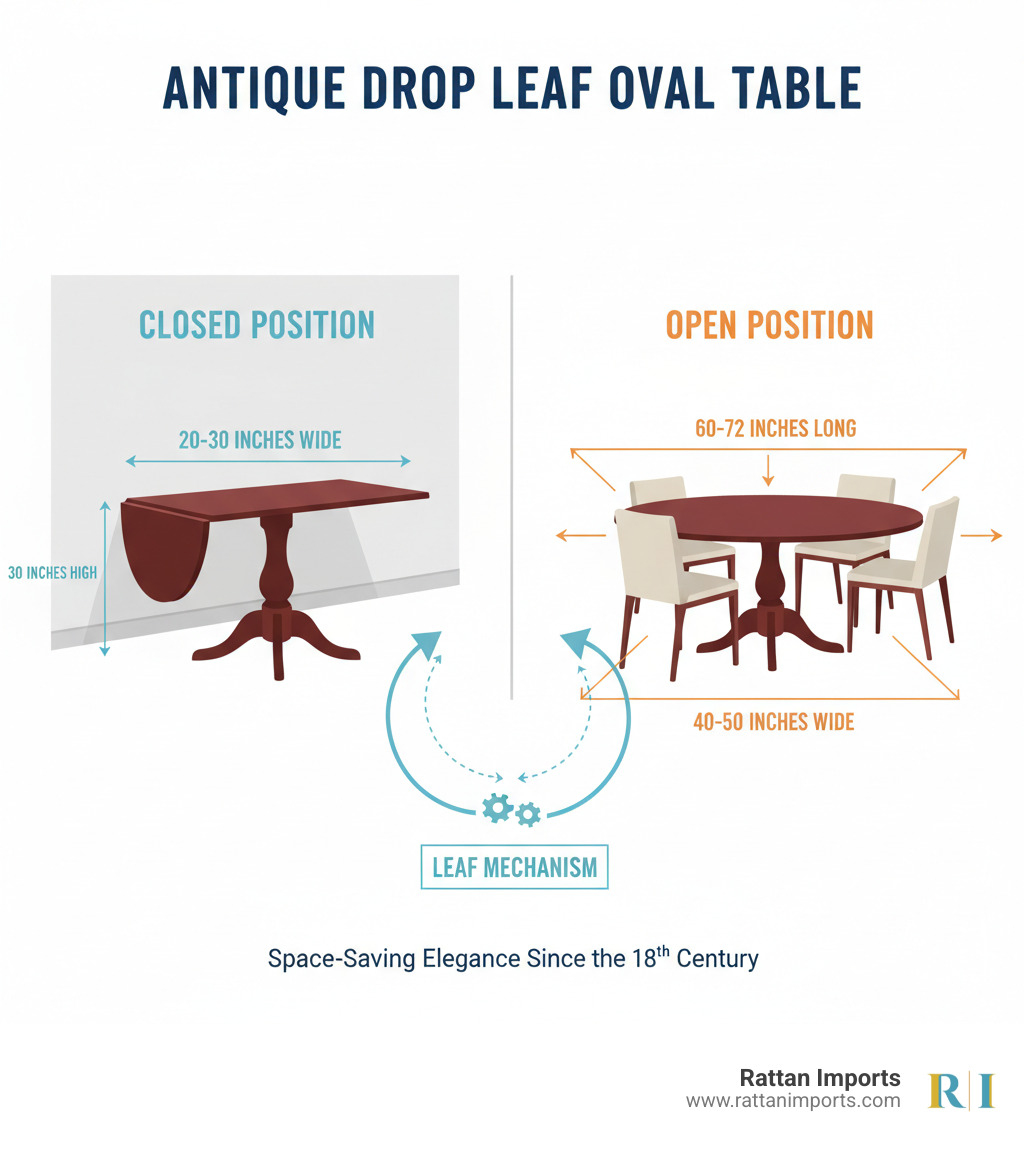
A Journey Through Time: Popular Styles and Eras
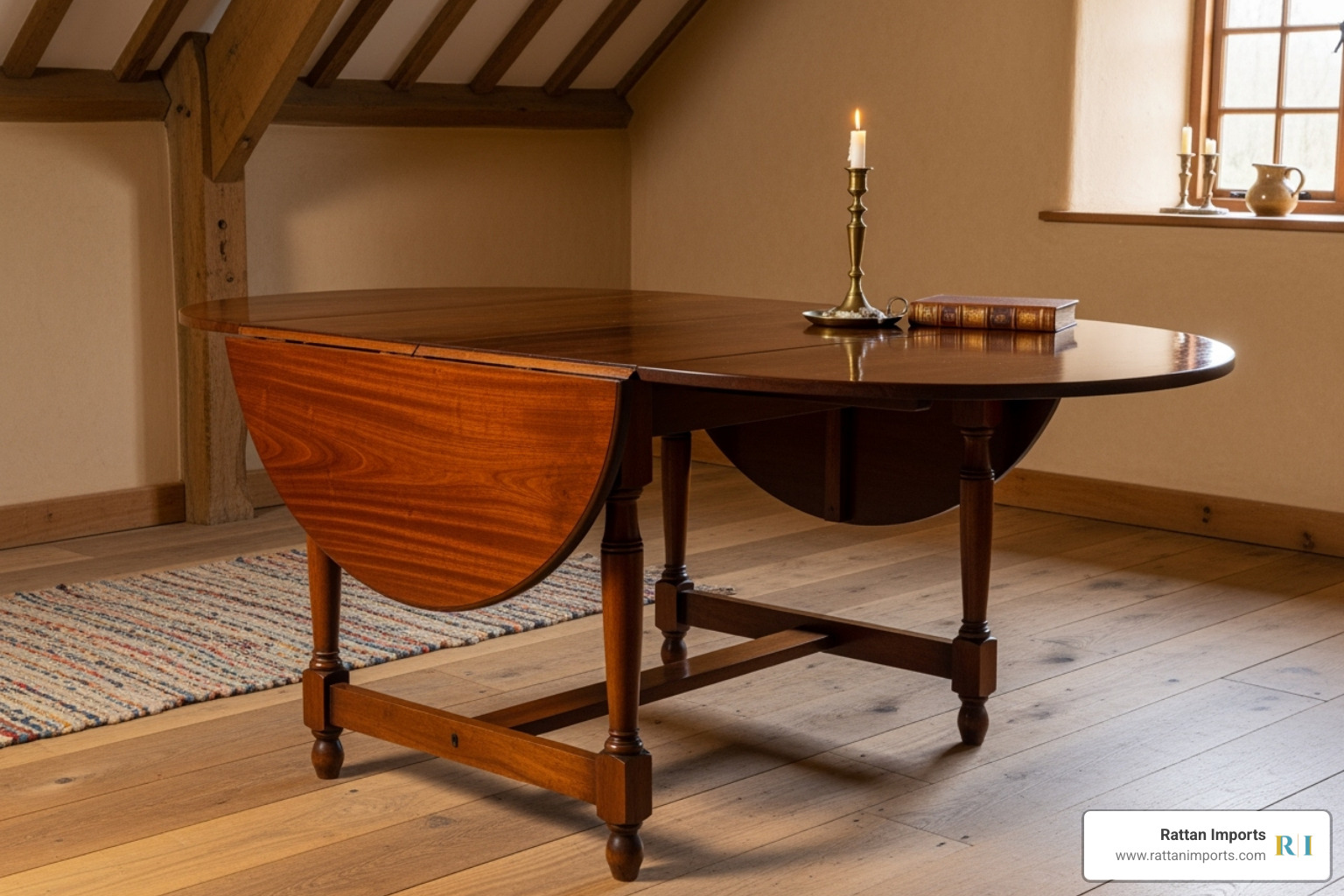
Every antique drop leaf oval table tells a story of its era. These pieces evolved with changing lifestyles, adapting their style while keeping their space-saving magic. Understanding these periods helps you appreciate the rich history behind each table.
The story begins in the 17th century with the sturdy gateleg table. These early tables, often of heavy oak, featured legs that swung out like gates to support the leaves. Built for practicality in country homes, they could be folded against a wall to free up floor space.
The 18th century was the golden age of drop leaf design. The Queen Anne style introduced graceful cabriole legs, while Georgian tables were known for perfect proportions and intricate carving. The refined Sheraton style featured slender, tapered legs with neoclassical touches.
This period also gave us the beloved Pembroke table. Legend says Henry Herbert, the 9th Earl of Pembroke, commissioned this smaller, lighter version with its signature central drawer. These neat tables became treasured pieces in English homes and make up a significant portion of antique tables available today.
The 19th century made a statement with Victorian and Empire styles using darker woods like walnut and mahogany. Table legs became more ornate with heavy carving and fluted details, turning functional pieces into status symbols.
In the 20th century, the design continued to evolve. Mid-Century Modern designers acceptd the concept with cleaner lines and lighter woods, while styles from William and Mary to Danish Modern proved the table's adaptability and practical charm.
The beauty of collecting these tables is that each era offers something different. Whether you're drawn to the rustic simplicity of early gateleg designs or the refined elegance of Georgian craftsmanship, there's an antique drop leaf oval table that perfectly matches your style.
Creating a stylish dining space that blends historical pieces with modern comfort is a rewarding experience.
The Anatomy of an Antique Drop Leaf Oval Table
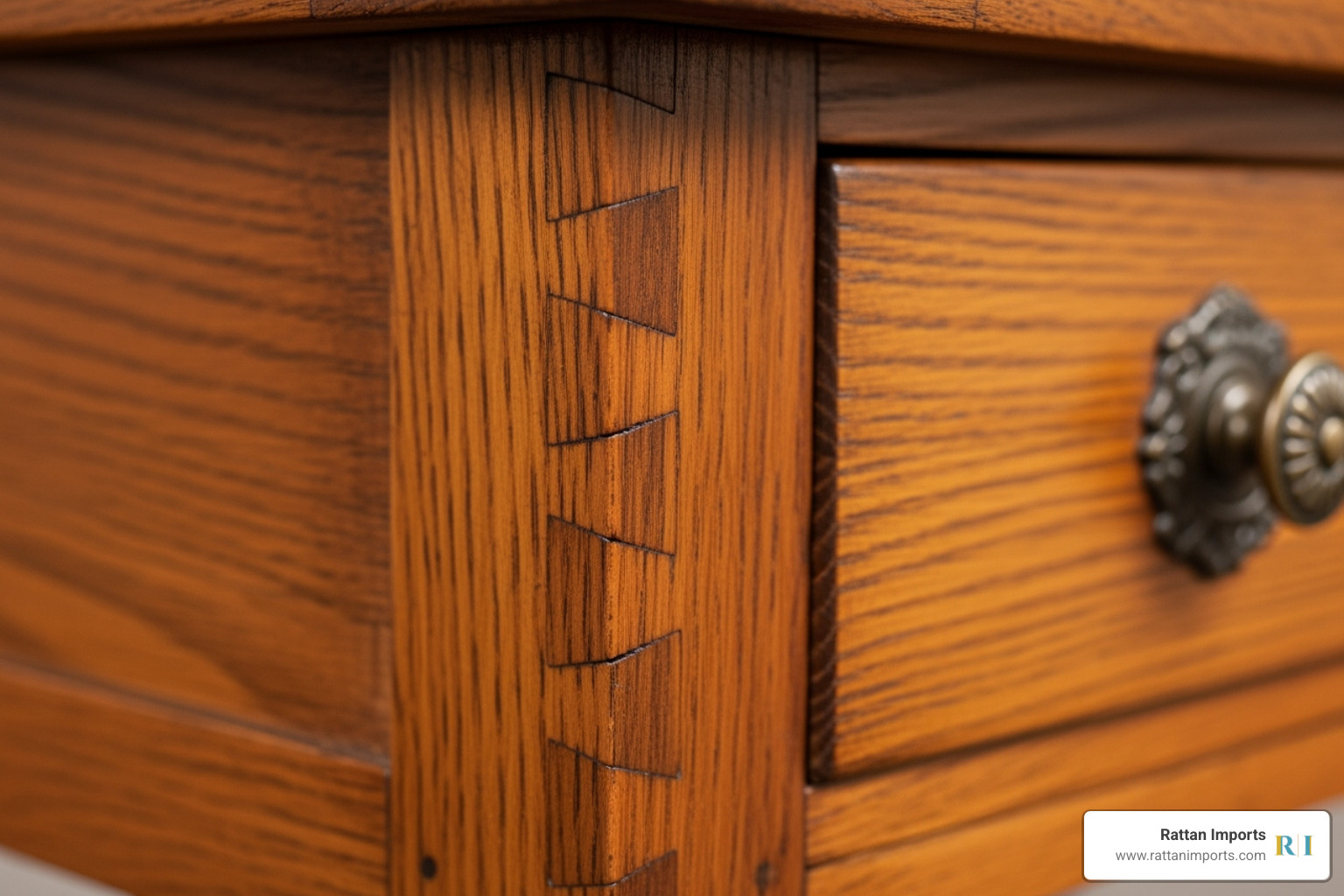
When you run your hand along the surface of an antique drop leaf oval table, you're touching centuries of craftsmanship. These pieces tell their stories through every joint and carved detail. Understanding what makes each table unique helps you appreciate the skill that went into creating something both functional and enduring.
The magic of these tables lies in their ability to transform from a modest console into a spacious dining surface through ingenious mechanisms refined over hundreds of years.
Design Variations and Features
The heart of any drop-leaf table is its support system. Each variation solved the same problem differently, creating distinct personalities that collectors cherish.
The gateleg is the classic design, featuring hinged leg sections that swing out like gates to support the extended leaves. When closed, the legs fold against the frame for a compact profile. Many feature decorative barley twist legs, adding visual interest. The Early C.18th Oval Oak Gateleg Drop Leaf Country Dining Table is a timeless example with its turned gun barrel supports and twin gate legs.
Pembroke tables are a more refined, lighter version, often with a central drawer for storage. Instead of full gates, they use hinged brackets called "flyers" to support the leaves. Often set on casters, they were portable and versatile, serving as desks, tea tables, or dining surfaces in Georgian and Victorian homes.
The Sutherland table is an ingenious space-saver. Remarkably narrow when closed—sometimes just 10 inches wide—its long leaves are supported by legs that pivot from the center to create a substantial dining surface. It's a prime example of functional furniture engineering.
Pedestal base designs emerged later, featuring a central support that often splits or expands to hold the top. This offers maximum legroom and a clean, uncluttered look that suits both traditional and contemporary settings.
How Materials Affect an Antique Drop Leaf Oval Table
The wood chosen for an antique drop leaf oval table shapes its appearance and longevity. Each species brings its own character to the piece.
Mahogany was prized for its durability and rich, reddish-brown color that deepens with age, making it the choice for formal, high-end pieces. Its fine, straight grain polishes beautifully, creating a glowing surface.
Oak was the backbone of country furniture, known for its strength and distinctive grain. Oak tables have a rustic, honest feel, reflecting generations of daily use. The English Oval Oak Drop-Leaf Table with Single Drawer and Baluster Legs exemplifies this sturdy beauty.
Walnut, popular in the Victorian era, is beloved for its rich, dark color and stunning grain. It offers a sophisticated look suitable for both formal and casual settings and holds intricate carving details well.
Cherry adds warmth with its reddish hue that deepens over time, developing a beautiful patina. Its fine grain and smooth finish were perfect for refined country and colonial styles treasured by collectors.
The choice of wood affects not just appearance, but how the table ages. Understanding these differences helps you choose a piece that will complement your space for years to come.
For those looking to create a complete dining experience that honors both traditional craftsmanship and modern needs, a comprehensive guide on choosing the perfect dining table can be an invaluable resource.
The Savvy Collector's Guide: Identification, Value, and Sourcing
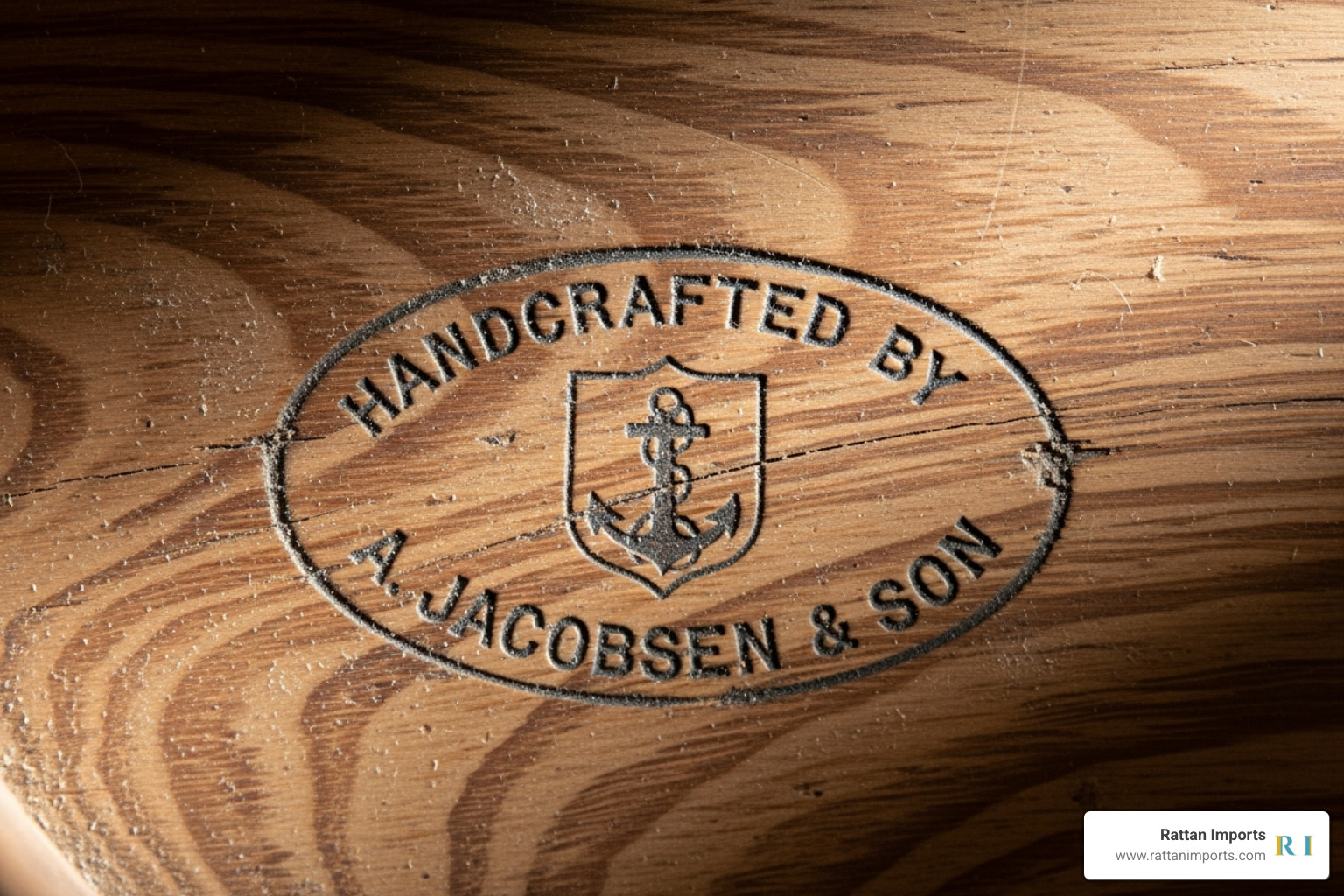
Hunting for the perfect antique drop leaf oval table is like a detective story. Each piece reveals its age, origin, and value through tiny details, and the thrill of finding an authentic treasure is incredibly rewarding.
Reading the Clues: How to Identify Authentic Pieces
Authentic antiques have subtle signs of their past. When examining an antique drop leaf oval table, look for hand-cut dovetail joints inside drawers. Their slight imperfections are a hallmark of pre-industrial craftsmanship.
The patina—a rich sheen developed over centuries of use—is a key indicator of age. An authentic patina feels smooth and shows gentle wear in places where hands have rested.
Hardware also provides clues. Early pieces may have wooden pulls or hand-forged nails, while later ones feature brass or ceramic fittings. The hinges can also help date the table.
Wood choice points to specific eras. Oak was common in the 17th and early 18th centuries, while mahogany was popular in the Georgian and Victorian periods. Look for construction methods like wooden pegs instead of modern screws to verify age.
Understanding Value in Today's Market
Several factors determine the price of an antique drop leaf oval table. Condition is paramount; a piece with its original finish and honest wear is often more valuable than a heavily restored one. Minor aging adds character that collectors prize.
Rarity also affects value. Tables with unusual woods, regional features, or ties to known makers are more expensive. Documented provenance, or ownership history, can dramatically increase a piece's worth.
Material quality and craftsmanship are key. Solid mahogany or fine walnut pieces are typically more valuable. Details like intricate baluster legs, smooth mechanisms, and hand-carved elements reflect the maker's skill and add to the price.
Current market prices for authentic pieces range widely, from around £425 to £2,950, depending on all these factors. Europe remains a common source, with the United Kingdom alone accounting for 340 listings in today's market.
Learn more about understanding antique condition terms to help you evaluate pieces more confidently.
Where to Find Your Perfect Table
The search for an authentic antique drop leaf oval table can take you down many paths. Local antique shops offer hands-on inspection and expert stories. Estate sales and flea markets require patience but can yield incredible finds. Online marketplaces connect you with dealers worldwide, providing detailed descriptions and photos. Specialized antique dealers often curate exceptional, authenticated pieces. Auctions, both online and in-person, are excellent sources for unique, high-quality items with detailed provenance.
The 19th century represents the most common period available today, with 344 listings currently on the market, giving collectors plenty of Victorian and Empire-style options to choose from.
Living with History: Styling, Care, and Practicality
The true magic of an antique drop leaf oval table is its ability to adapt to your life. One moment it's a discrete console; the next, it's hosting a dinner party. This makes these pieces perfect for modern living.
Space-saving design is the biggest advantage. When the leaves drop, the table becomes a narrow console. When guests arrive, it expands to accommodate everyone. Each table carries historical character that mass-produced furniture can't match—you're becoming the next chapter in its story.
These pieces are natural conversation starters and a sustainable choice, giving beautiful craftsmanship a new life.
Living with antiques does require some understanding. They can be more delicate and require specific maintenance. Their imperfections are part of their story, though some may prefer a pristine look. Also, note that solid hardwood construction makes many of these tables quite heavy.
Learning the difference between side tables and end tables can also help you choose the right table style for your space.
Styling Your Vintage Table in a Modern Home
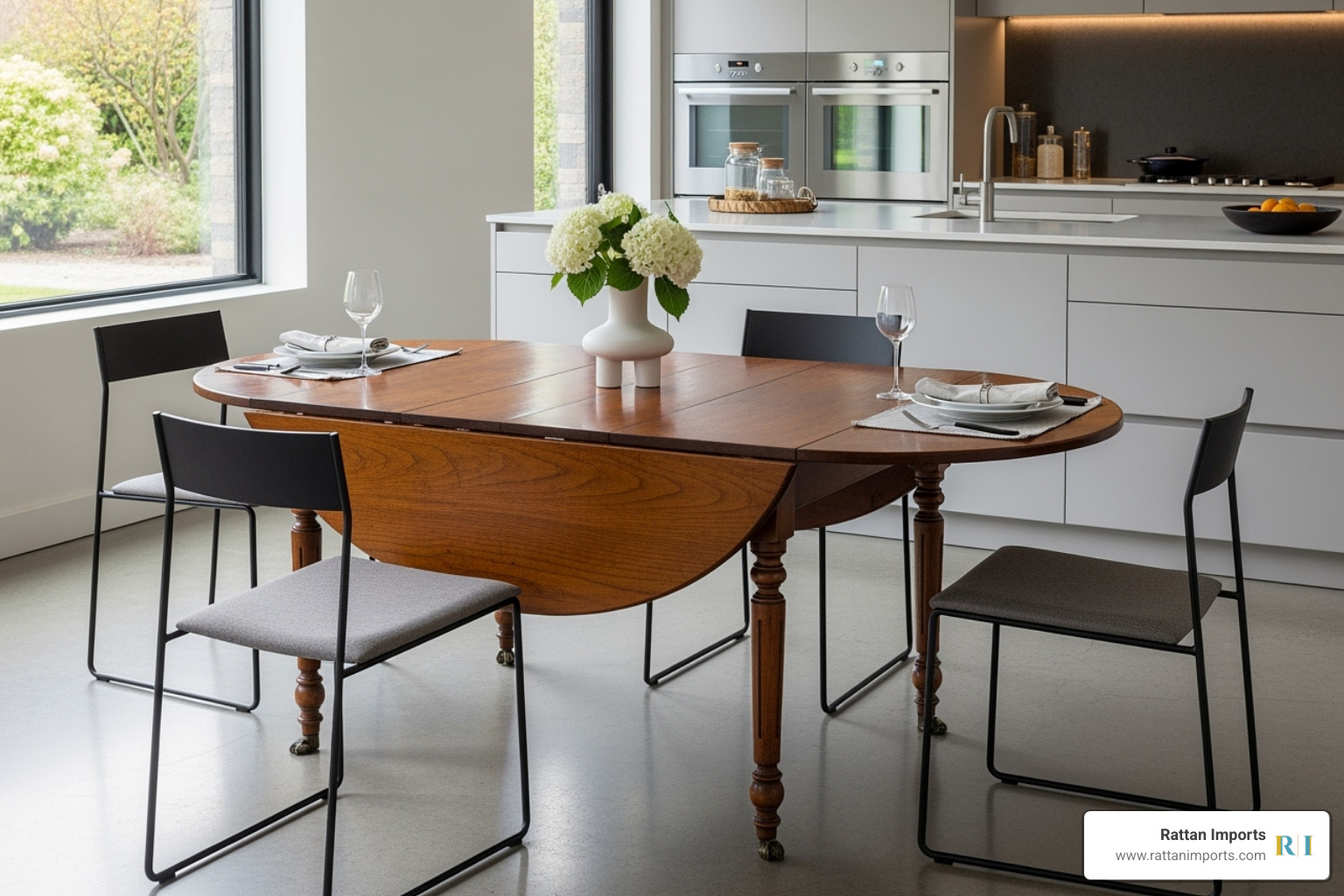
The beauty of an antique drop leaf oval table shines when you mix old with new, adding warmth and character to any decorating style.
In your dining room, pair your antique table with modern seating, like wicker dining chairs for comfort and design, for an eclectic look. The oval shape encourages intimate gatherings.
In your living room, use it as a narrow console table behind a sofa when the leaves are down. It provides surface space without overwhelming the room.
In an entryway, use it as a focal point with a flower arrangement or a bowl for keys to greet guests with style.
In a home office, it serves as an adaptable desk. Extend the leaves for a large workspace and drop them to save space, adding historical character to your work area.
It's perfect for a cozy breakfast nook. The oval shape is great for conversation, and it expands easily for weekend brunches.
Essential Care and Maintenance Tips
Caring for your antique drop leaf oval table is simple but requires thoughtfulness to ensure it thrives for generations.
Gentle cleaning is best. Use a soft, slightly damp cloth to remove dust, and avoid harsh chemicals that can damage the finish.
Quality polishing with a high-quality paste wax once or twice a year will nourish the wood. Avoid silicone spray polishes, which can cause buildup.
Smart protection is key. Keep the table out of direct sunlight and away from heat sources. Always use coasters and placemats to prevent marks.
Regular functionality checks keep things working. Periodically test the hinges and supports. A bit of wax or mineral oil can keep them moving smoothly. Consult a restorer for any loose parts.
Humidity control is important. Stable humidity (40-60%) helps prevent the wood from cracking or warping as it naturally expands and contracts.
Frequently Asked Questions about Antique Drop Leaf Tables
When you're considering adding an antique drop leaf oval table to your home, it's natural to have questions. Understanding their nuances helps you make the best choice for your space and lifestyle.
What's the difference between a gateleg and a Pembroke table?
The main differences are size and support structure. A gateleg table is typically larger and sturdier, with leaves supported by full legs that swing out like a gate. They often feature decorative turned legs, such as the barley twist style. A Pembroke table is smaller, lighter, and more refined. Its leaves are supported by hinged brackets called "flyers" that pivot from the frame. Pembrokes often have a central drawer and casters, making them versatile accent pieces.
How much is an antique drop leaf oval table worth?
The value of an antique drop leaf oval table depends on several factors. Age and period are key, with 18th-century Georgian or Queen Anne pieces often being more valuable. Condition is crucial; an original finish with a natural patina is highly desirable, sometimes more so than a restored piece. Material quality also plays a big role, with hardwoods like mahogany, walnut, and cherry typically commanding higher prices. Finally, craftsmanship details such as hand-cut dovetails or intricate carvings add to the value. Prices can range from a few hundred dollars to several thousand, with current listings from UK dealers showing a range of £425 to £2,950.
Can you use an antique drop leaf table for everyday dining?
Yes, you can! These tables were built to be hardworking centers of family life. Before committing to daily use, ensure the table is structurally sound. Check for firm legs, stable joints, and a smooth mechanism; a restorer can fix minor issues. To protect the surface from spills and heat, always use placemats, coasters, and trivets. A custom-cut glass top is another option for heavy use. Also, ensure your dining chairs are a comfortable height and there is enough legroom. With proper care, your antique table can serve your family for years to come.
Conclusion: Embracing Timeless Versatility

When you bring an antique drop leaf oval table into your home, you're not just adding furniture—you're welcoming centuries of stories, craftsmanship, and ingenious design. These remarkable pieces have been solving space challenges and bringing families together since the 1700s, and they're just as relevant today.
Think about it: where else can you find a piece that transforms from a sleek console table into a dinner party centerpiece in seconds? Whether you're living in a cozy apartment or a spacious home, these tables adapt to your life, not the other way around.
The magic lies in their perfect balance of beauty and brains. A Georgian gateleg table with its graceful turned legs brings elegance to any room. A sturdy Victorian piece in rich walnut adds warmth and character. Even a Mid-Century interpretation proves that good design truly is timeless.
What I love most about these pieces is how they connect past and present. When you run your hand across that smooth, aged patina, you're touching the same surface where countless meals were shared, letters were written, and memories were made. That's something you simply can't get from mass-produced furniture.
Mixing an antique drop leaf oval table with modern pieces creates the kind of layered, personal space that feels truly lived-in. Your antique table paired with contemporary chairs tells a story about who you are—someone who values history, appreciates quality, and isn't afraid to break the rules.
At Rattan Imports, we understand the importance of creating spaces that reflect your unique style. While we specialize in beautiful rattan and wicker pieces, we believe every home benefits from mixing textures, eras, and stories. Our rattan dining sets are designed to complement both vintage treasures and modern aesthetics.
Your home should be a reflection of all the things you love—and an antique drop leaf oval table might just be the perfect piece to tie it all together. After all, the best furniture doesn't just fill a space; it enriches your life.


